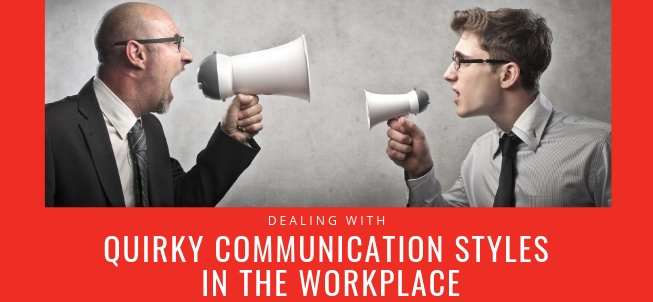Businesses often have a guide on how employees should communicate with customers. Social media etiquette often has to be followed. Grammar, punctuation, and clarity are always checked when sending a mass text message out to customers using a solution like TrueDialog. Emails need to be replied to in a timely manner. The list goes on. However, there’s not really a guide employees can use when communicating with each other.
It’s a fact of life that we deal with a variety of personalities and communication styles in the workplace. It’s a wonder we can ever get our point across. With intranet software, it is a lot easier to communicate with your colleagues compared to shouting over one another.
Communicating should be simple, but sometimes we complicate a conversation or situation because we have an agenda, we lack awareness of social cues, we forget how to use courtesy and tact, or we’ve become apathetic. In short, we don’t listen and don’t gauge the receptiveness of our audience.
Whether a business uses sd wan providers, Microsoft Teams, or a simple email, there will always be some people who don’t use their time to communicate effectively. People also come with different standards and different boundaries, creating even more misunderstandings, frustration and even toxic workplace relationships.
Flexibility Is the Key to Accommodating Other Communication Styles
The reasons for communication breakdowns can include:
- Stubbornness-when one party is not willing to listen or compromise
- The need to always be right-even when it makes matters worse
- Unwillingness to adjust to the other person’s communication style-this is what it all boils down to, and what needs to be fixed to have a conversation that yields productive results.
[bctt tweet=”Whether it’s the Interrupter, the Storyteller or the Advisor-dealing with different #CommunictionStyles in the #workplace can be challenging. Take a breath and learn to cope productively. ” username=”rosalindatweets”]
While there are many styles of communication, I list the top three quirks that come up during my presentations.
1. The Interrupter
This is someone who is naturally impatient and often a poor listener. The Interrupter is prone to waiting to the last minute to address important concerns and thinks nothing about turning everyone else’s life upside down. They are compelled to constantly share and connect, and may come across as self-centered and inconsiderate, lacking basic soft skills.
You can handle them in conversation by saying, for example: “I appreciate your enthusiasm but I’d like to finish my thought before I forget.” Or: “I’d like to hear about that, but let’s stick to the topic at hand.”
If they drop by your office or cubicle unannounced, you could try: “I can’t answer that right now. I’ll get back to you in a half-hour.” Or: “No, I’ve got to focus on this; come back at 4:00.”
2. The Storyteller
Usually well meaning, the Storyteller tends to sprinkle the conversation with before-and-after details that aren’t relevant to the topic at hand. He or she likes to talk and believes they are interesting. They ignore any subtle nuances and social cues as they doggedly plow to the end of the story, no matter what.
What should you do? Well, if you have the leisure, listen to them and consider it your kind deed for the day. However, when time is short, try: “I’m sorry to cut you off but I’ve got to get back to work.” (Who can argue with that?) Or: “Good for you. Sounds like you have a lot going on. Unfortunately, so do I. Got to get back to work.” And if you feel you need to soften your response, add: “Maybe we can catch up later.”
3. The Advisor
This person is given to sharing their solicited and unsolicited opinions about everything. Most of the time their advice is well meaning, but some Advisors can be know-it-alls who create controversy and alienate coworkers.
The best time to stop them is when they begin with: “If I were you . . . ” Or: “I can tell you exactly how to handle that . . . ” Calmly thank them for their concern. This will make them feel acknowledged as you politely say, “I’m going to handle this one on my own. Thanks.” Or: “I appreciate your input.” Or: “I appreciate it, but at this time I’ve got enough advice to consider.”
What Is Your Communication Style?
Keep in mind as you are dealing with other people’s communication quirks, you probably have some of your own. If you saw yourself in any of the above communication styles in the workplace, that’s fine. No one wants you to completely change your personality, but you can learn to make adjustments.
You can also look at this as an opportunity to evaluate how well your current communication skills are working for you. Is the way you express yourself and interact with others on the job helping or hindering you? And, how is it affecting your relationships?
Productive communication requires awareness of others, strong listening skills, tact and a little patience.
_____________________________________________________________
Rosalinda Oropeza Randall, Workplace Civility, Soft Skills, Business Etiquette Expert, Media Source, and author of “Don’t Burp in the Boardroom.”
Presentations are available to support HR policies and harassment compliance, address concerns, or to avert potential conflicts – Upgrade or set a standard of communication and behavior – Up-and-coming managers – Interns – New-hire orientation process – Professional development events or conferences – College/university students – Actors to prepare for roles – NEW! Attorneys: polish your client’s professional presence for a court appearance.
For more information, please contact me via email, or by calling 650.871.6200, before a dilemma turns into front-page news.









